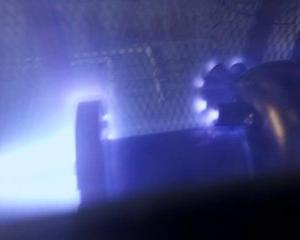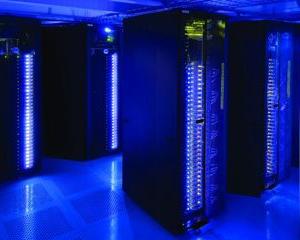我们正在设计, 发展中, 建筑, and testing novel SRF structures for a variety of accelerator applications: linear accelerators, 对撞机, 还有光源. 这些结构覆盖了很宽的频率范围, 粒子速度, 物质(电子), 质子, 离子), and can be used for either the acceleration or deflections of particle beams. This area of research is fully multidisciplinary and draws on 应用数学, 计算机科学, 经典力学和电磁学, 机电工程.
Our pursuit combines expertise in the atomic collision and gas discharge physics to advance plasma science approach that aims to resolve a number of issues created by the progress of contemporary accelerators and accelerator-based light sources. We are 发展中 plasma processing and beam production technologies, all for the purpose of inventing and advancing new compact light sources. 目前, we are 发展中 generic experiments and models that reflect the geometry and processing objectives of accelerator cavities. 在另一组实验中, we are also studying charged particle transport from the solid/vacuum interface of contaminated walls at actual operational conditions. We are working to resolve the effect of secondary electron emission on the multipactor and field emission phenomena.
Advancements in the field of accelerator physics are unimaginable without high-fidelity computer simulations. A multidisciplinary team of researchers from the various departments -- physics, 计算机科学, 应用数学, 工程和其他——设计, develops and deploys high-performance computer simulations aimed at simulating existing and future particle accelerators. At the time when different computational platforms offer varying degrees of massive parallelism, we aim to achieve optimal performance by matching algorithms with underlying computer architecture. Examples of such high-performance computational tools currently in use or under development at the CAS are:
- Multidimensional non-linear optimization code based on genetic algorithms. We apply these codes to various problems related to accelerator performance and design, 例如射频注入器和腔体的优化, 粒子对撞机的亮度, 动态孔径, 动量验收, 色差校正等.
- Computer code for simulating long-term dynamics in particle 对撞机 -- including beam-beam effects, 动态孔径, 动量验收, 运行稳定性等效果.
- Computer code for simulation of coherent synchrotron radiation in light sources and storage rings.
Our computer efforts are supported by the CPU/GPU clusters at the Jefferson Lab and the ODU.
One of the outstanding issues of the accelerator science and technology is related to the fundamental physics and materials science which limit the performance of superconducting resonator (SRF) cavities. The state of the art Nb cavities can generate very high electromagnetic fields close to the theoretical breakdown limit of the Meissner state so that the surface resistance, the quality factor and the RF breakdown field are determined by complex interplay of nonequilibrium superconductivity, 杂质和材料缺陷. The physics of superconductivity under such extreme conditions of strong electromagnetic fields, and the limits to which the SRF performance can be pushed by the materials modifications are not well understood. The SRF group has been investigating both theoretically and experimentally the rf properties of superconductors for accelerator applications, particularly the nonlinear surface resistance and breakdown of superconductors under strong rf fields. We are measuring the rf properties of conventional and novel superconductors over a wide range of frequency, 温度, and rf field to understand the interplay of superconducting properties and materials defects and to optimize the SRF cavities. We are also exploring new ways of improving the performance of superconducting cavities by materials modifications, impurity management and nanoscale multilayer nanostructuring using new superconducting materials to push the SRF performance beyond the intrinsic limits of Nb for the next generation particle accelerators.
When relativistic electrons interact with a high-field laser beam, intense and highly collimated electromagnetic radiation is generated through Compton scattering. The relativistic upshifting of the scattered photon energy can be used to produce useful photon beams from a compact source. We are using our superconducting RF and beam transport expertise to develop a world-class integrated design for a compact inverse Compton scattering light source. Our design efforts include all aspects of the Compton electron accelerator, 包括一个超导光注入器, 超导辐条腔加速直线加速器, 以及六维束压缩.
我们正在设计, 发展中, 建筑, and testing novel SRF structures for a variety of accelerator applications: linear accelerators, 对撞机, 还有光源. 这些结构覆盖了很宽的频率范围, 粒子速度, 物质(电子), 质子, 离子), and can be used for either the acceleration or deflections of particle beams. This area of research is fully multidisciplinary and draws on 应用数学, 计算机科学, 经典力学和电磁学, 机电工程.
Our pursuit combines expertise in the atomic collision and gas discharge physics to advance plasma science approach that aims to resolve a number of issues created by the progress of contemporary accelerators and accelerator-based light sources. We are 发展中 plasma processing and beam production technologies, all for the purpose of inventing and advancing new compact light sources. 目前, we are 发展中 generic experiments and models that reflect the geometry and processing objectives of accelerator cavities. 在另一组实验中, we are also studying charged particle transport from the solid/vacuum interface of contaminated walls at actual operational conditions. We are working to resolve the effect of secondary electron emission on the multipactor and field emission phenomena.
Advancements in the field of accelerator physics are unimaginable without high-fidelity computer simulations. A multidisciplinary team of researchers from the various departments -- physics, 计算机科学, 应用数学, 工程和其他——设计, develops and deploys high-performance computer simulations aimed at simulating existing and future particle accelerators. At the time when different computational platforms offer varying degrees of massive parallelism, we aim to achieve optimal performance by matching algorithms with underlying computer architecture. Examples of such high-performance computational tools currently in use or under development at the CAS are:
- Multidimensional non-linear optimization code based on genetic algorithms. We apply these codes to various problems related to accelerator performance and design, 例如射频注入器和腔体的优化, 粒子对撞机的亮度, 动态孔径, 动量验收, 色差校正等.
- Computer code for simulating long-term dynamics in particle 对撞机 -- including beam-beam effects, 动态孔径, 动量验收, 运行稳定性等效果.
- Computer code for simulation of coherent synchrotron radiation in light sources and storage rings.
Our computer efforts are supported by the CPU/GPU clusters at the Jefferson Lab and the ODU.
One of the outstanding issues of the accelerator science and technology is related to the fundamental physics and materials science which limit the performance of superconducting resonator (SRF) cavities. The state of the art Nb cavities can generate very high electromagnetic fields close to the theoretical breakdown limit of the Meissner state so that the surface resistance, the quality factor and the RF breakdown field are determined by complex interplay of nonequilibrium superconductivity, 杂质和材料缺陷. The physics of superconductivity under such extreme conditions of strong electromagnetic fields, and the limits to which the SRF performance can be pushed by the materials modifications are not well understood. The SRF group has been investigating both theoretically and experimentally the rf properties of superconductors for accelerator applications, particularly the nonlinear surface resistance and breakdown of superconductors under strong rf fields. We are measuring the rf properties of conventional and novel superconductors over a wide range of frequency, 温度, and rf field to understand the interplay of superconducting properties and materials defects and to optimize the SRF cavities. We are also exploring new ways of improving the performance of superconducting cavities by materials modifications, impurity management and nanoscale multilayer nanostructuring using new superconducting materials to push the SRF performance beyond the intrinsic limits of Nb for the next generation particle accelerators.
When relativistic electrons interact with a high-field laser beam, intense and highly collimated electromagnetic radiation is generated through Compton scattering. The relativistic upshifting of the scattered photon energy can be used to produce useful photon beams from a compact source. We are using our superconducting RF and beam transport expertise to develop a world-class integrated design for a compact inverse Compton scattering light source. Our design efforts include all aspects of the Compton electron accelerator, 包括一个超导光注入器, 超导辐条腔加速直线加速器, 以及六维束压缩.







